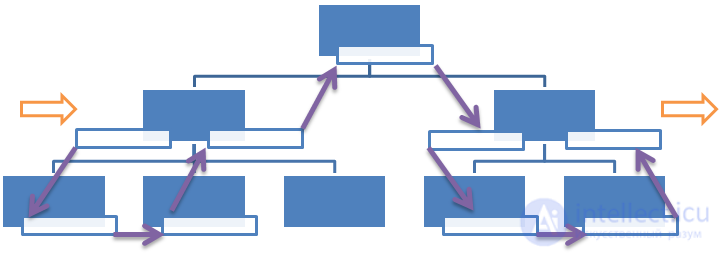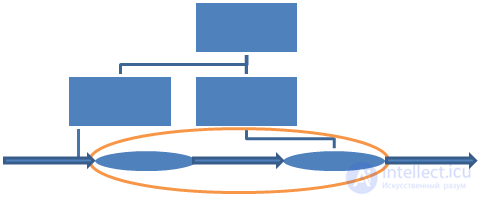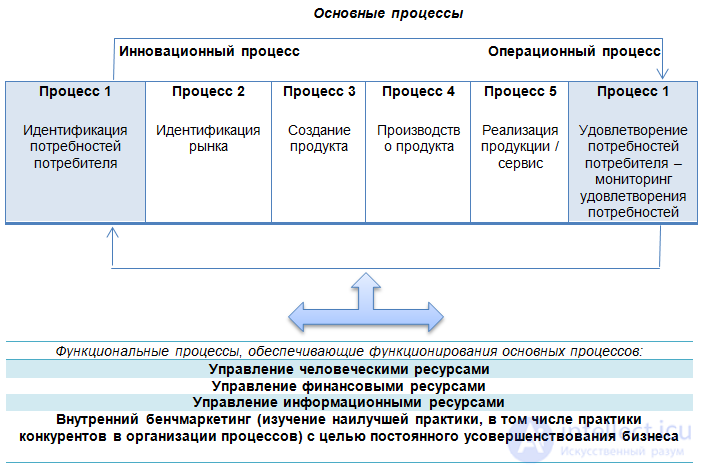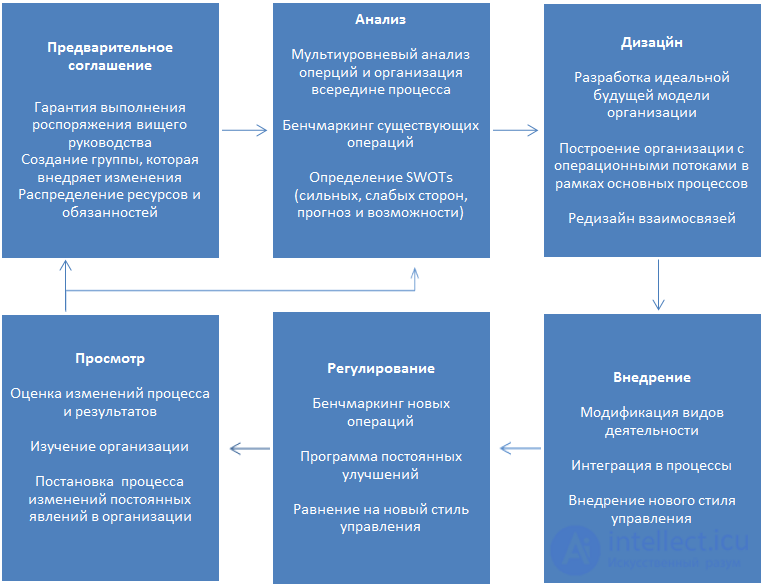Lecture
On the other hand, the process can be viewed as a sequence of direct actions carried out "on top" of the existing organizational structure, while the functions assigned to the departments ensure the achievement of the final results of the process.
Responsibility for achieving the goals set in the system of performance indicators (in the integrated system of monitoring business results - Balanced Scorecard), and for making improvements lies with the process manager.
Sometimes cross-process business organization is confused with matrix organization (Fig. 2). Unlike cross-process business organization, in a matrix organization there is no consumer orientation, there is a conflict atmosphere between management levels and project managers, an increased complexity of coordinating functions, and not cooperation.

Fig. 2. Matrix organization
Reengineering cannot be called a new method of managing a company, because its foundations were laid back in the 1980s, and successful testing by large foreign companies has been going on since the beginning of the 1990s. In particular, according to Ernst & Young, in 1997, the largest banks in North America spent in 1997 about 2.8 billion dollars only on the reengineering of their units. The growth rate of the tool market for BPO in recent years has averaged 40% per year.
However, the introduction of BPO in Ukraine has specific features related to the inheritance that went to domestic enterprises from the command-administrative system of economic management. So, reengineering involves such changes in the organization of business of domestic companies:
Moreover, it is reengineering as a revolutionary method of point / complex transformation of a company that will allow not only to stay “afloat”, but also to provide Ukrainian companies with long-term prospects for development and growth.
For effective implementation of reengineering, it is necessary to abstract from the existing functional business organization, questioning the accepted methods of company management. Naturally, the management of enterprises must have the determination to make changes and try to perceive the situation in the enterprise allegedly “from the side”.
The organizational structure of the majority of Ukrainian enterprises, regardless of their industry sector and legal status, was aimed at production; a hierarchical, authoritarian control system, an opaque and often inadequate control system, which negates the motivation of staff (Fig. 3). The disadvantages of this structure are:
→ Staff Motivation
So, one of the many problems in the enterprise, the restructuring of which was carried out by the Ukrainian Center of Post-Privatization Support of Enterprises, was that the application with a request to reduce the price of products came first to the sales department, which, having no system of possible discounts, referred it to the director ( in case of his absence, no one had the authority to solve this problem). Then the application was transferred to the economic department, which submitted its conclusion on the possibility of reducing the price. At the same time, market factors were not taken into account in pricing (including the elasticity of demand), which, ultimately, led to the loss of sales markets. Duplication of functions by several departments leads to an increase in production costs. Naturally, the enterprise suffered greatly from such an organization of the decision-making process - the buyer either bought similar products from competitors or sought dumping prices. Information about dumping was distributed instantly, and potential buyers did not want to buy products at a high price.
Thus, the company, having the ability to compete only on price (in the absence of differentiated products / brand), did not realize this. Naturally, there was no need to talk about eliminating the liquidity crisis and reducing the shortage of working capital, since the company worked in the short term.
This example demonstrates the disadvantages of a linear-functional organizational structure, eliminated through the introduction of business process reengineering. The transition to "symbolic management", that is, to the delegation of authority of the personnel of an enterprise, allows employees to be involved in processes whose ultimate goal of implementation is customer satisfaction. As practice shows, thanks to "symbolic management", positive results are achieved faster by increasing employee motivation.
? Enterprise business processes
But back to the example in question. Due to the recommendations of consultants for the transition to a process-oriented organization (Fig. 4), in particular, the duplication of functions of the sales department and the economic department were eliminated.

Fig. 3. Passing the document in accordance with the rules and procedures of the hierarchical structure

Fig. 4. Passing a document in a process-oriented organization
Thus, the submission process “application satisfaction” of the process “Sales of products and after-sales service” (Fig. 5) provided the functions of one division, the pricing strategy for target market segments was developed as an input to the subprocess, taking into account the level of profitability required for an enterprise (process results 1, 2 in Fig. 5). The process of “Sales of products and the implementation of after-sales service” also supported the function of the sales department “Collecting information to meet customer needs”, the results of which were then transferred for processing to the process of “Identification of customer needs” (the unit whose function is to process this kind of information is marketing department). This structure, in particular, provided a focus on long-term prospects and an immediate response to changes in market conditions that have changed in the market. And, finally, the abolition of the duplication of functions has reduced the cost of production.
The system of delegation of authority also allowed the director to be excluded from the decision-making process on sales and after-sales service, since he does not have the necessary marketing research data for this, obtained as a result of the implementation of the processes “Identification of consumer needs” and “Identification of market needs” (Fig. 5), and in general, should not be involved in solving this kind of issues.

Fig. 5. Optimal organization of top-level business processes in an enterprise (after restructuring)
The transition from a linear-functional organization to a process-oriented or point transformation of an organization is based on the implementation of the value chain for creating goods / services (Table 1), at the beginning and end of which the consumer is located. Only after this, as a result of evolution, and not revolution, is it advisable to resort to the reorganization of the organizational structure that will support the functioning of the processes in the organization.
? Optimization of the organizational structure
Tab. 1. Primary Value Chain
|
Support |
Company infrastructure |
Supplier-Partner Relationship Structure |
Strategy |
Debt management and financing |
|
|
Human Resource Management |
Recruitment |
Management Experience |
The development of new vertical / horizontal |
Business skills development |
|
|
Technical growth |
Development (design) of operations |
Financial control |
Marketing Database |
Support databases |
|
|
Stocking |
Supplier-Partner Relations |
Partner relationship with the service |
|
Relationship partners with the service |
|
|
Primary activity |
Inbound delivery |
Operations |
Outbound delivery |
Marketing and sales |
Service |
The value chain is an analytical method created by Michael Porter, which allows you to analyze and optimize any type of company activity (building its business processes), determine tasks and priorities in any area of business and properly allocate efforts and resources to achieve maximum competitiveness.
Depending on the type of activity (production, trade, financial services, etc.), the interdependence and location of key elements of a company's competitive advantages change. For example, for a wholesaler, the “operation” and “supply” positions are critical. For a reseller, service is an important point. However, for both categories, price and cost control in all parts of the value chain to the consumer is critical.
Thus, a comprehensive analysis of existing business processes in an enterprise (Fig. 6, “Analysis”) from the point of view of creating consumer value will make it possible to identify the strengths and weaknesses of business organization. The former must be eliminated, while the latter must be kept in the new structure. Comprehensive analysis also includes benchmarking - continuous systematic search, study of the implementation of best business organization practices.

Fig. 6. Stages of implementation of RBP in the enterprise
On the basis of a comprehensive analysis, a reference model of business organization is being developed, that is, a model in which it is necessary to try to bring the existing system of business organization closer, in which the goals of future improvements are laid down (see Fig. 6, “Design”). A business performance appraisal system (BSC) is created in accordance with the existing business objectives set.
And finally, the implementation (see Fig. 6, “Implementation”) provides for the implementation of the goals laid down in the reference model, reducing the impact of negative factors, cooperation (introducing a new management style). That is, rebuilt and modified activities, from the point of view of the consumer value chain, should be integrated into the processes of creating consumer value. This, in turn, implies a reduction in the need for interfunctional coordination (the dominance of divisions of divisions is canceled), that is, the transaction costs are reduced, the cycle time of the processes, the system is quickly adapting to customer requirements and changes in external constraints.
As soon as changes are made (implementation), the integrated processes become subject to regulation (see Fig. 6 “Regulation”), which is based on benchmarking (see Fig. 6 “Analysis”, “Regulation”).
The concept of “benchmarking” is worth dwelling in more detail, since its implementation is a critical factor in the success of all the changes made.
According to the definition, Benchmarking is a continuous, systematic search, study of the best practices of competitors and enterprises from related industries, as well as constant comparison of desired changes and business results with the own business organization created by the reference model. On the basis of the received - the creation and support of the system of continuous improvements in business performance.
Comparison takes place at the corporate, process level and activity level (Fig. 7). There are a number of subsystems that allow you to evaluate and create a program of continuous improvement of business results ABC, CSF, QFD, TCA, TBC, BSC, ROI, TTM.

Fig. 7. Enterprise benchmarking system
ABC (Activity Based Costing) - cost management, based on the identification of sources of costs, distribution and control of overhead costs by type of activity, accurate monitoring and elimination of types of activity, do not bring additional value to the consumer. Analysis of the organization by type of activity in the context of each main process allows revealing significant reserves of cost reduction and eliminating types of actively duplicating ones and those that do not bring additional value to the consumer.
CSF (Critical Success Factors) - a system for analyzing the critical factors for a company's success, allows you to create and maintain competitive advantages, expressed in:
QFD (Quality Function Deployment) is a new product / service development system that effectively responds to consumer needs, reducing the time it takes for an enterprise to enter the market and ensuring an increase in the company's share in the market. The system must be implemented in every enterprise.
TCA (Transaction Cost Analysis) is a system for evaluating the costs of coordinating processes. The use of this system allows you to optimize communication between processes.
TBC (Time based Competition) is a system for evaluating "temporary competition", the introduction of which allows you to coordinate the activities of an enterprise on the market over time.
BSC (Balanced Scorecard) is a comprehensive system for monitoring business results. The use of this system allows the company to monitor the following components: the efficiency of operations (in terms of quality), personnel activities (in terms of the organization’s perspectives), customer satisfaction (prospects for working with the consumer), financial condition (in terms of financial perspectives), long-term strategy (its prospects). The advantage of the system is a clear quantitative and qualitative expression of the estimated business results at the same time in the context of all the above-mentioned components.
ROI (Return On Investment ) - an assessment of the return on investment, allowing to evaluate the return on the company's internal and external investments.
TTM (Time-to-market) - time to market. The indicator tracks the total time spent by an enterprise in responding to needs that have appeared or changed on the market, the time it takes to deliver a product / service to the market. Given that the product life cycle becomes shorter, the assessment of this indicator and the adoption of appropriate actions on the market are critical for any organization.
The results of the benchmarking of new operations will be the basis of the company's continuous improvement program for the long term. In particular, it can lay the foundation for Total Quality Management, serve as the basis for the implementation of ISO 9000 certification.
The final stage is “Viewing” (see Fig. 6).The purpose of this stage is to monitor changes occurring in the organization and in the external environment, to implement the process of changes in the company on an ongoing basis. At the same time, it is necessary to proceed from two principles: “nothing is perfect,” “nothing is static.” As an estimate, a quantitative part is used, based on the results of the benchmarking process, qualitative elements such as the degree of customer satisfaction, the quality of jobs, and the company's perception of what is happening.
Существуют и другие методы поддержания эффективности РБП, в том числе внедрение информационных технологий для трансформации и поддержки кросс-процессной организации бизнеса. Построено только базис для разработки уникального решения компанией, позволит в большей степени ориентироваться на требования потребителя, быть конкурентоспособной и использовать информационные технологии эффективно: не только для автоматизации документооборота, но и для автоматизации управления предприятием.
Comments
To leave a comment
Analysis and reengineering of business processes
Terms: Analysis and reengineering of business processes